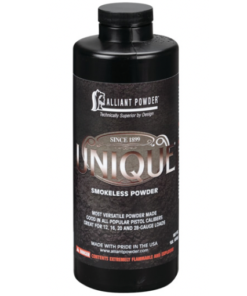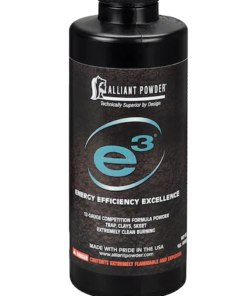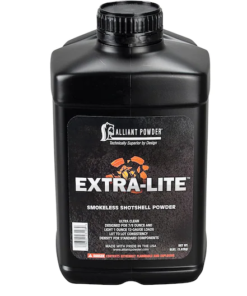Smokeless powder
Shop Smokeless Powder. Hodgdon Powder, IMR Powder, Alliant Powder, Accurate Powder, Ramshot Powder, Vihtavuori Powder, Shooters World
Of the hundreds of different mixtures and compounds discovered to have an explosive nature, perhaps the best known are, gun-powder, gun-cotton, nitro-glycerine, dynamite, mixtures of potassium chlorate, picrate compounds, fulminates of mercury, Silver, copper, etc., and smokeless powder. However those having no bearing on the development of smokeless powder will not be considered.
Gun-powder is the oldest known explosive, and was first used in warfare as early as the year 1350. It is composed of potassium-nitrate, carbon and sulphur, in proportions of 75%, 13%, and 12% respectively, and these proportions have varied but slightly in its entire history.
Gun-powder is purely a mechanical mixture, the various components being finely pulverized, mixed thoroughly, and the fine dust sifted off. Although affected but little by frost or cold, it is susceptible to fire, and moisture renders it useless. Continued experiments following its discovery showed that the violence of its explosion and the time of its burning could be regulated by caking the powder into grains and pellets, which resulted in its continued use for guns of all descriptions.
The disadvantages of the standard type of gun-powder are very apparent. The bore deposit is considerable, rendering a frequent cleaning of the gun necessary. The smoke arising from the discharge of even a small quantity is excessive, and obscures the vision of the gun’s crew for a considerable length of time. When used in small arms by skirmishers or sportsmen, it makes the position of the marksman at once evident. Also the limit of velocity for the different calibred guns was soon reached, and no forward steps were being made. It was not, however, until the discovery of gun-cotton and nitro-glycerine, that the possibility of obtaining a smokeless powder was considered.
Smokeless explosives, of which gun-cotton and nitro-glycerine are the most important, were first discovered in 1832, by Braconnot, who found that starch dissolved in nitric acid and then washed out with water became highly explosive. Shortly after, Pelouse obtained the same results by using cotton fabrics instead of starch. It was not until 1846, however, that Schonbein succeeded in obtaining a true gun-cotton, from using a mixed bath of nitric and sulphuric acids. This fibrous cotton was seized upon eagerly as a smokeless explosive, and rammed into cases and used with such disastrous results, that it was soon given up. An Austrian, Von Lenk, persisted in trying to overcome the erratic and violent nature of the explosive by regulating the rate of burning, which he did to some extent by braiding together wisps of uniformly dense fibre.
In 1863, he organized the first smokeless explosive battery, consisting of six 12-pdr. guns, and used the explosive with success for a year. Then two large magazines blew up, from unknown causes, and it was abandoned. The English government had watched these experiments carefully, and they were taken up in 1863 by Sir Frederick Abel. In 1865 he published his process of manufacturing gun-cotton, which marked a new era in the history of this explosive. Although improvements have been made in the machinery, the process practically remains the same to-day, and will be considered later.
Smokeless powder is a type of propellant powder. It is a single-based or double-based colloidal nitrocellulose mixture. It is extremely flammable and can easily ignite and burn under normal conditions. Under specific conditions, smokeless powder can detonate. (Smokeless powders are classified under the Explosives Regulations as Type P.2.)
The following guidance is for anyone involved with smokeless powder. For situations not covered here, including exemptions and conditions, consult the Explosives Regulations.
Buying smokeless powder
You are permitted to buy smokeless powder if you are 18 or older unless otherwise exempted by the Explosives Regulations. For more than 75 kilograms of smokeless powder in a storage unit or more than 25 kg in a detached dwelling, you must have an explosives licence.
Storing smokeless powder
Storage requirements for users
Smokeless powder must be stored in its original packaging or in ammunition (small arms cartridges).
If you do not have an explosives licence, smokeless powder must be stored in a dwelling (such as a house, apartment or cottage) or a storage unit.
If you have an explosives licence, smokeless powder must be stored in the magazine specified in your licence. Propellant powder (smokeless powder or black powder, also known as gunpowder) and primers (percussion caps) must be stored in separate magazines.
Dwelling
The amount of smokeless powder you are permitted to store in a detached dwelling (such as a house, apartment or cottage) or a storage unit attached to a detached dwelling depends on whether you are also storing black powder. You are permitted to store up to 25 kilograms of propellant powder (smokeless powder and black powder combined), but the amount of black powder must be 10 kilograms or less.
You are permitted to store up to 5 kilograms of smokeless powder in an attached dwelling (such as a house, apartment or cottage) if it is in containers that are greater than 1 kilogram.
You are permitted to store up to 20 kilograms of smokeless powder in an attached dwelling if it is in containers that are 1 kilogram or less.
You are permitted to store up to 25 kilograms of smokeless powder in a detached dwelling or a storage unit that is attached to a detached dwelling. This amount includes all the propellant powders at the dwelling.
You must store the smokeless powder away from flammable substances and sources of ignition. You must ensure that they can be accessed only by people you have authorized.
Storage unit
You are permitted to store up to 75 kilograms of smokeless powder for use in a storage unit that is not attached to a dwelling.
- The storage unit must be in a dry place, away from flammable substances and sources of ignition.
- The storage unit must prevent unauthorized access and protect the contents from weather.
- If the storage unit is a container, it must not block exit in case of fire.
- If the storage unit is not a container, all exits must be kept clear.
- Any shelving in the storage unit must be made from a non-sparking material (for example, wood or painted metal).
- Only ammunition (small arms cartridges), black powder, primers (percussion caps) or black powder cartouches are permitted to be stored with the smokeless powder.
- Smokeless powder and black powder, primers, ammunition and black powder cartouches must be stored separately (for example, on different shelves or separated by a wooden barrier).
- The storage unit must be monitored when it is unlocked.
- The storage unit must be kept clean, dry, organized and free of grit.
- Any spill, leakage or other contamination must be cleaned up immediately.
- You must take steps to minimize the risk of fire in or near the storage unit.
- You must post a sign that displays the words “Danger — Fire Hazard/Risque d’incendie” in letters at least 10 centimetres high on the storage unit in a clearly visible location. The sign must also prohibit smoking using letters or a symbol at least 10 centimetres high.
Storage requirements for sellers
If you hold an explosives licence, you are permitted to buy and store more than 75 kilograms of smokeless powder you intend to sell.
If you do not hold an explosives licence, you must send written notice to the Chief Inspector of Explosives before you are permitted to sell propellant powder (smokeless powder or black powder). This notice must include your name, address, telephone number, fax number and email address, as well as the date on which you will begin to sell propellant powder.
If you do not hold a licence, the smokeless powder that is not displayed for sale must be stored in a storage unit in a sales establishment or a dwelling.
If you hold an explosives licence, the smokeless powder that is not displayed for sale must be stored in the magazine specified in your licence.
Propellant powder (smokeless powder and black powder) and primers (percussion caps) must be stored separately from each other.
Other articles where smokeless powder is discussed: warship: Armament: …began to achieve success with smokeless powder of nitrated cellulose and usually some nitroglycerin. With greater striking power available, armour-piercing projectiles became more formidable. These were originally solid shot designed simply to punch through armour plate. In the 1890s, better steel and fuses made it possible to add an explosive…
Smokeless powder
Smokeless powder
Smokeless powder
Smokeless powder
Smokeless powder
Smokeless powder
Smokeless powder
Smokeless powder
Smokeless powder
Smokeless powder
Smokeless powder
Smokeless powder

















